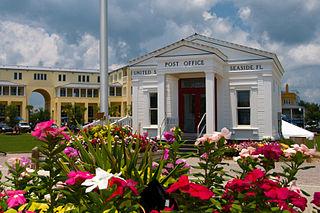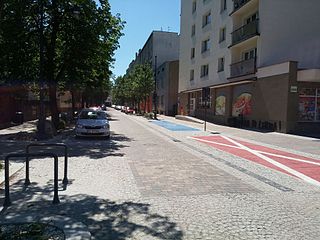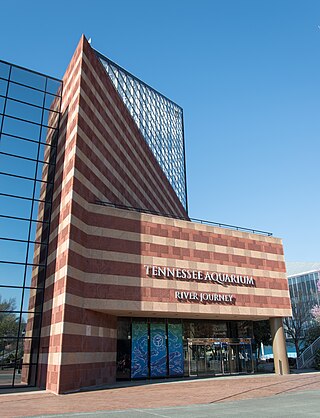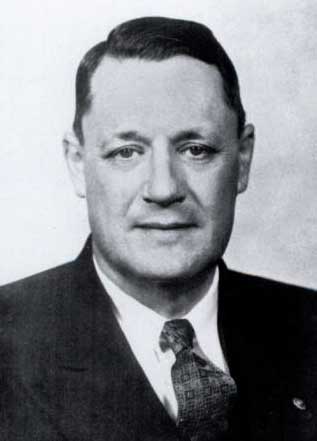
Chattanooga is a city in and the county seat of Hamilton County, Tennessee, United States. It is located along the Tennessee River, and borders Georgia to the south. With a population of 181,099 in 2020, it is Tennessee's fourth-largest city and one of the two principal cities of East Tennessee, along with Knoxville. It anchors the Chattanooga metropolitan area, Tennessee's fourth-largest metropolitan statistical area, as well as a larger three-state area that includes Southeast Tennessee, Northwest Georgia, and Northeast Alabama.

New Urbanism is an urban design movement that promotes environmentally friendly habits by creating walkable neighbourhoods containing a wide range of housing and job types. It arose in the United States in the early 1980s, and has gradually influenced many aspects of real estate development, urban planning, and municipal land-use strategies. New Urbanism attempts to address the ills associated with urban sprawl and post-Second World War suburban development.

A living street is a street designed with the interests of pedestrians and cyclists in mind by providing enriching and experiential spaces. Living streets also act as social spaces, allowing children to play and encouraging social interactions on a human scale, safely and legally. Living streets consider all pedestrians granting equal access to elders and those who are disabled. These roads are still available for use by motor vehicles; however, their design aims to reduce both the speed and dominance of motorized transport. The reduction of motor vehicle dominance creates more opportunities for public transportation. Living Streets achieve these strategies by implementing the shared space approach. Reducing demarcations between vehicle traffic and pedestrians create a cohesive space without segregating different modes of transportation. Vehicle parking may also be restricted to designated bays. These street design principles first became popularized in the Netherlands during the 1970s, and the Dutch word woonerf is often used as a synonym for living street.

Built in 1890, the 2,376-foot-long (724 m) Walnut Street Bridge connects Chattanooga, Tennessee's downtown with North Chattanooga. The bridge's main spans are pin-connected Pennsylvania through truss spans. The top chord of these truss spans are configured in five sections, making the spans similar to the Camelback truss design. The bridge is historically significant as an extremely long and old example of its type; according to the Historic American Engineering Record: "The bridge was apparently the first non-military highway bridge across the Tennessee River."

Interstate 124 (I-124) is an unsigned designation for a short segment of a controlled-access highway located in Chattanooga, Tennessee.

The Tennessee Aquarium is a non-profit public aquarium located in Chattanooga, Tennessee, United States. It opened in 1992 on the banks of the Tennessee River in downtown Chattanooga, with a major expansion added in 2005. The aquarium, which has been accredited by the Association of Zoos and Aquariums (AZA) since 1993, is home to more than 12,000 animals representing almost 800 species.

Ronald C. Littlefield is an American politician and the former mayor of Chattanooga, Tennessee. He was elected via a run-off election in 2005 after a long term as a city councilman. He was reelected in 2009. He is the former executive director of Chattanooga Venture.
The term "sustainable communities" has various definitions, but in essence refers to communities planned, built, or modified to promote sustainable living. Sustainable communities tend to focus on environmental and economic sustainability, urban infrastructure, social equity, and municipal government. The term is sometimes used synonymously with "green cities," "eco-communities," "livable cities" and "sustainable cities."

The Hunter Museum of American Art is an art museum in Chattanooga, Tennessee. The museum's collections include works representing the Hudson River School, 19th century genre painting, American Impressionism, the Ashcan School, early modernism, regionalism, and post-World War II modern and contemporary art.

The P. R. Olgiati Bridge, often called the "Ol' Johnny" or "Ol' Jolly", is a steel girder bridge across the Tennessee River in Chattanooga, Tennessee completed in 1959. It is named for former mayor and long time political boss of Chattanooga, P.R. Olgiati. Chattanooga was a growing city during the 1950s. To expand the city and to allow more ways to cross the Tennessee River, the P. R. Olgiati Bridge was one of multiple bridges built. The route carries US 27 across the Tennessee river.

The Lyndhurst Foundation is a Chattanooga, Tennessee-based grant-making foundation organized in 1938 by Coca-Cola Bottling Company magnate Cartter Lupton. The Lyndhurst Foundation was the first private foundation in Tennessee, and it focuses on the enrichment and enhancement of the social, natural, and built environment in Chattanooga, Tennessee, and the surrounding southeastern region.
Planning and development in Detroit since the late 20th century has attempted to enhance the economy and quality of life of Detroit, Michigan, United States. In 1970, the private group Detroit Renaissance began to facilitate development in the city. Its successor, Business Leaders for Michigan, has continued to facilitate development into the 21st century. Projects have included new commercial facilities, revitalization of neighborhoods, hospitality infrastructure, and improvements to recreational and public facilities, such as the QLine light rail project.

The Tennessee Riverwalk is a 13-mile (21-km) riverside path which parallels the Tennessee River from the Chickamauga Dam to downtown Chattanooga, Tennessee. It is part of the Tennessee Riverpark System featuring the Tennessee Riverpark, Coolidge Park, Renaissance Park, Ross's Landing, the Walnut Street Bridge, the Blue Goose Hollow section and the old U.S. Pipe property.

The Institute for Transportation and Development Policy (ITDP) is a non-governmental non-profit organization that focuses on developing bus rapid transit (BRT) systems, promoting biking, walking, and non-motorized transport, and improving private bus operators margins. Other programs include parking reform, traffic demand management, and global climate and transport policy. According to its mission statement, ITDP is committed to "promoting sustainable and equitable transportation worldwide."
Highland Park is a neighborhood in the city of Chattanooga, Tennessee. It originally was a small city developed between the late 19th century and the mid-20th century. It is located two miles east of downtown Chattanooga, and bounded by Willow and Holtzclaw streets on the east and west, and McCallie and Main streets on the north and south. It was incorporated in 1905. Later, when it was incorporated into the City of Chattanooga in 1929, it grew to become a popular middle-class suburb with access to multiple train lines. As employment and much downtown property value in Chattanooga declined throughout the 1970s, Highland Park did as well, but it has had significant recent success due to its proximity to the downtown, its vibrant neighborhood association, and many newly renovated historic houses.

The Sustainable Transport Award (STA), is presented annually to a city that has shown leadership and vision in the field of sustainable transportation and urban livability in the preceding year. Nominations are accepted from anyone, and winners and honorable mentions are chosen by the Sustainable Transport Award Steering Committee.
The following is a timeline of the history of the city of Chattanooga, Tennessee, United States.
Kim H. White was president and CEO of River City Company in Chattanooga, Tennessee. River City Company is a non-profit organization created in 1986 to aid in the redevelopment and revitalization of downtown Chattanooga. White has been with River City since 2009. Before that, she was president and CEO of the Corker Group and of Luken Holdings. White is a graduate of Hixson High School and the University of Tennessee at Chattanooga. Senator Corker praises White's work as head of River City.
On February 9, 1893, Alfred Blount, an African American and a Chattanooga native, was taken from his jail cell in the county jail and brutally beaten, stabbed, and hanged from the Walnut Street Bridge in Chattanooga, Tennessee. Blount was charged with assault of a woman by the name of Mrs. M. A. Moore. Moore, 51 and widowed, claimed she was cleaning her house when a man entered through her back door requesting food. Moore, assuming it was a neighbor of hers, invited the man in and called out to her African-American house boy Sam to bring the man some food. Upon realizing Sam's absence, Moore herself went into the kitchen to prepare food before reporting being grabbed by the arm and attacked by the man. After hitting the man with her hand, Moore fainted and laid unconscious in her house before recalling the incident to her neighbor, Mrs. DeRochement.

Peter Rudolph "Rudy" Olgiati was the 55th Mayor of Chattanooga, Tennessee from 1951 to 1963. During his time in office, Olgiati oversaw the arrival of the interstate highway, the beginning of the Civil Rights Movement, and the city's first urban renewal project. He is often accused of being one of Chattanooga's last political bosses. He is also the namesake of Chattanooga's P.R. Olgiati Bridge.















